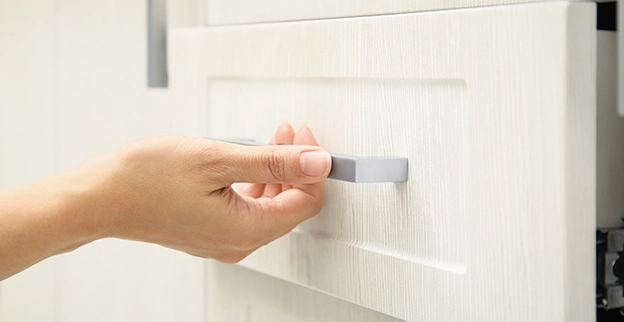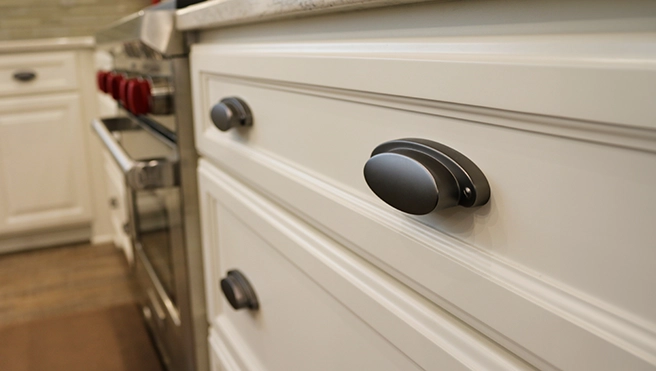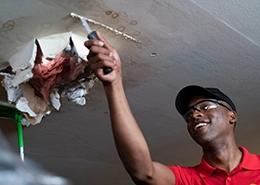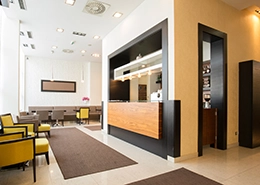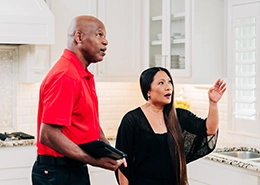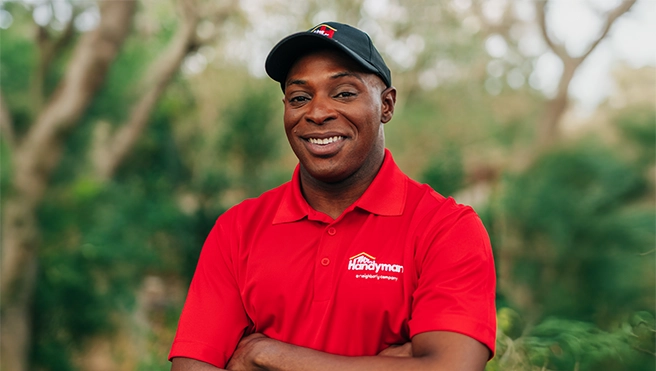If you have inadequate space for effective organization, you may have even taken it upon yourself to assemble makeshift and separate cabinets that you can purchase from any local home hardware store. However, they may not be as durable as you'd like them to be. A professional cabinet installation from an experienced carpenter differs from your ready-made and store-bought solution. At Mr. Handyman, we offer customized items for your interior living spaces. Plus, we securely fasten new units to your wallboards expertly. You'd be surprised at the difference a built-in solution for installing cabinets makes compared to a temporary one.
Before you become complacent and begin stowing away certain kitchen appliances into your garage, basement, or toolshed, reach out to Mr. Handyman’s local pros at (972) 400-4771 to find out what we can do for you. Among our wide range of handyman services, there is cabinet installation. Dallas homeowners must not compromise on their home's storage! Call our expert and experienced team members today and see their skillset, tactics, and know-how for installing cabinets for yourself!
Our Dependable Dallas Cabinet Installation Services
Mr. Handyman boasts an impressive track record, having served Dallas and surrounding areas of Ferris, Grand Prairie, or Hutchins for the last 16 years and onwards. We always advocate for our clientele by genuinely listening to their viewpoints by offering authentic, effective, and long-lasting solutions to cabinet installation. Dallas residents who are indecisive about remodeling their kitchen or bathroom space can always schedule a no-obligation consultation in which they can customize a solution for you based on your personal preferences, budget, and other accommodations such as aging in place or for persons with disabilities. Recall that we offer transparent, upfront pricing for installing cabinets alongside a one-year part and labor guarantee, so if your cabinet's hinges become loose, we will return and make the proper adjustments. It's admirable you're attempting to do a DIY cabinet installation, but let's face it–it's best left to the pros. The last thing you need is for your cabinet to look slightly skewed and off-kilter due to incorrect placement or even a wobbly shelf from a loose hinge.
Our Professional Handyman's Area of Expertise For Cabinet Installation
Our carpentry professionals can handle everything from tweaking loose nuts and bolts for installing cabinets to conducting a total overhaul of your home's cabinet system and layout. From the get-go of performing a thorough inspection of your wallboards for any previous water and moisture damage to removing old, damaged cabinets and measuring and outlining the boundaries for the new cabinet layout–we possess the dexterity to handle a standard cabinet installation. Dallas property owners must understand it's not a matter of just affixing and mounting a bunch of hallow boxes to their walls–we have to carefully calculate and measure other aspects such as marking off the location of wall studs, ensuring hardware including drawer handles and pulls are accessible and checking to see if the floor level is even and aligns with the cabinet installation so you can approach the cabinet from a safe distance. Here is what else we take into consideration for installing cabinets:
Our Established Process for Cabinet Installation: Dallas
Standard Types Of Cabinets We Handle
Base: This standard cabinet sits on the floor and is usually responsible for supporting kitchen and bathroom countertops and sinks. The base cabinet sets the layout for a room's floor plan and usually provides a generous amount of storage space, measuring, on average, 24 inches wide and 36 inches tall.
Wall: This type of storage space is affixed onto the wallboard and allows you to customize it based on different heights, multiple weights, and depths. It usually measures about 12 inches in depth but can be expanded up to and including 17 inches. They sit directly above base cabinets and are great for storing items that need to be accessed quickly as you are standing or moving about the room.
Tall: A tall or high cabinet is mounted onto the floor and extends vertically upwards towards the ceiling and is mostly used as a substitute for a walk-in pantry and food storage or as a broom cupboard to store cleaning supplies. It typically measured 15 to 30 inches wide and approximately 84 inches in height.
Specialty Units: This type of cabinet maximizes the square footage of your house by taking up the entire expanse of your wallboard's backsplash and consists of corner cabinets, sink/cooktop fronts, buffet hutch, and bottle racks. These cabinets can be customized to a specific design, unlike stock cabinets which come with preset measurements. These are great for kitchens with irregular shapes and tricky corners.
Standard Versions Of Cabinets
A cabinet is usually categorized into four types based on its grade of construction, including ready-to-assemble (RTA), stock, semi-custom, and custom.
Ready-to-Assemble (RTA): This type of cabinet is ready-made and pre-packaged with all the hardware required for its assembly and is typically more affordable. This is great for a DIY hack as it does not require special tools or skills and is easy for installing cabinets. The only drawback is that there is little ability for customization in terms of style, size, and material, so don't expect anything unique for your cupboards.
Stock: A stock cabinet is another affordable option and also comes in a sturdy and ready-made, and pre-built variety from the manufacturer and consists of boxes that are based on industry-standard styles and measurements. A stock cabinet is more inexpensive to install upfront and is easier and faster to mount. The only drawback is that, similar to ready-to-assemble cabinets, a stock cabinet is less versatile and cannot be customized to your specific preferences. Because they are mass-produced products, they cannot be altered in any way whatsoever as they have adhered to rigid standards for measurements.
Semi-Custom: A semi-custom cabinet installation, Dallas clients should note, offers much more versatility in terms of hardware, material, and finishes. It allows you to expand the cabinet's depth and even change the size of the drawer and swap out the door fronts. Although they are slightly pricier, the extra design modifications and alterations, including decorative enhancements and embellishments, make this a worthwhile investment. Just be mindful that for a cabinet installation, Dallas clients must be aware that they do have limitations and don't offer complete personalization for installing cabinets.
Custom: If you want to get down to the nitty-gritty details, a custom cabinet installation is your best bet. This type is exclusively designed to fit your living space and can be customized to niche design specifications, unlike their stock cabinet counterparts which have predetermined measurements. And so, for a cabinet installation, Dallas clients will receive more versatility and a diverse palette of styles, materials, hardware, and finishes. Plus, you can adjust the sizing to your preferences, and you can utilize the highest quality materials, for example, better door hinges and solid wood face fronts, given this extra flexibility. Although custom cabinetry for installing cabinets lets you be open to exploring the possibilities, it does have the highest price tag. But this makes sense; installing cabinets that are custom should be unique and built to last.
Common Cabinet Materials
Solid Wood: A popular option for cabinet installation, Dallas property owners appreciate this organic and natural wood material for its rustic appeal. It's durable and sustainably sourced as it's eco-friendly, easy to paint, and be refinished for minor damages multiple times, being an authentic material. The only drawbacks are that it's more expensive to install, plus you still have to maintain it through the occasional coat of paint or stain it so it doesn't rot away from water and moisture damage. Plus, it can become an all-you-can-eat buffet for pesky pests and termites.
Medium-Density Fiberboard (MDF): This material is a type of engineered wood that is denser than pure and solid hardwood. MDF contains wood fibers tightly wound together with wax and resin, which forge together into wood-based panels. MDF is also a durable material that showcases a smoother finish with a non-granular appearance. It's also a more affordable option compared to pure wood. Plus, it's resistant to water and moisture damage, including mold and mildew growth making it ideal for humid areas of the house, including the kitchen. The only drawback is that it doesn't bode well in fluctuating temperatures, can still be scratched, dented, and gouged under heavy amounts of pressure, and cannot be refinished for a cabinet repair, unlike solid wood.
Plywood: Another durable, lightweight material that doesn't crack, fracture, or warp compared to its solid wood counterpart is plywood. Plywood also bodes well in moisture-prone areas making it a great option for your kitchen and bathroom. Plus, as an added benefit, it's made from recycled wood sources, making it an environmentally-friendly option. Being a more affordable alternative than solid wood, too, and can be refinished for minor repairs, including scratches, dents, and chips all the same. The only drawback is that, given its granular structure, it can warp easily.
Particleboard: A strong, durable, simple, and lightweight material that is made of compacted and compressed wood chips, particleboard doesn't spit or warp as easily, given its minimalist design. The only drawback is that it cannot withstand heavy pressure and can buckle, so it's not the best choice for kitchen cabinets which normally hold heavy utensils and equipment, including pots, pans, and appliances.
Melamine: This is also made of engineered wood made in combination with MDF or particle board, giving it a tougher and more durable outer shell. Melamine then is resistant to fluctuating temperatures and moisture damage, plus it won't easily crack, scratch, dent, or chip, nor will it fade in color. It's a more affordable option compared to solid wood and plywood and doesn't compromise on any of its attributes. Although it's considered one of the reliable materials for cabinet installation, Dallas clients must note it's difficult to install, and if its outer coat wears off, it is still susceptible to chipping.
Laminate: Another aesthetically appealing wood-based option for installing cabinets is laminate, as it's also made in combination with either plywood, MDF, or particleboard which allows it to become a more durable and strong material. It has two varieties of being either low-pressure laminate which is more susceptible to cracks and dents, and high-pressure laminate, which is best reserved for areas of the house with more physical impact, such as the kitchen. Laminate is resistant to fluctuating temperatures, including excessive humidity and moisture damage, doesn't scratch, stain or dent readily, and is easier to clean compared to solid wood. But again, it's not indestructible and can still warp and wilt away. Another thing to keep in mind is that, unlike real solid wood, it cannot be refinished for minor repairs during a cabinet repair service, so it will have to be completely replaced through a cabinet installation.
Wood Veneer: Wood veneer material consists of natural wood being combined with a thin layer of MDF, fiberboard, or particleboard, and so it's a wood-based product rather than being purely organic, unlike solid wood. It's a popular option for a kitchen cabinet installation given its high durability, lightweight, and minimal maintenance, and best of all mimics the appearance of real wood and is sturdier than just laminate. The only drawback is that it's still vulnerable to water damage as its finish is not coated with a surface polish or stain, so be sure to completely dry off your dishware before stowing it away.
Stainless Steel: As a super durable material, a stainless steel cabinet installation will, of course, never be exposed to warping or cracking nor suffer the consequences of water and moisture damage and the aftermath of mold and mildew growth. Plus, it's resistant to fire and pests and not vulnerable to chemical exposure. Atop it all, it's also easy to maintain and clean thanks to the smooth and slick metal surfaces, which can be wiped down of any debris and residue. As a more modern style, you've probably noticed stainless steel cabinetry on your favorite professional chef competition television shows too! Just beware of cabinet installation; Dallas homeowners will find that it's expensive to install and is known to be a dust magnet.
Thermofoil: This is an innovative material made from a combination of vinyl laminate alongside an MDF core. Thermofoil doesn't easily crack, warp, or fade due to its plastic coating. The only drawback is that although thermofoil can handle fluctuating temperatures, it does not do well once exposed to very hot temperatures, so it is not a good choice for rooms that have heat appliances, such as the kitchen area plus, it's still vulnerable to excessive water and moisture damage so may not do so well in a hot, steamy bathroom.
